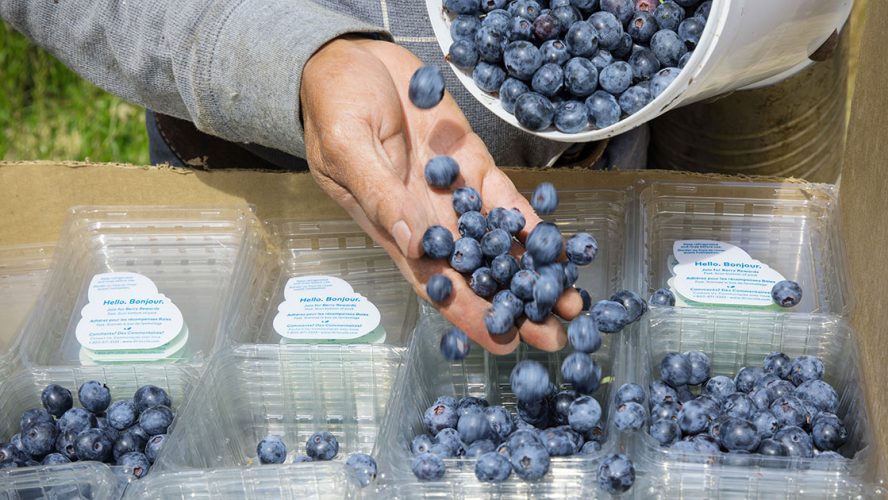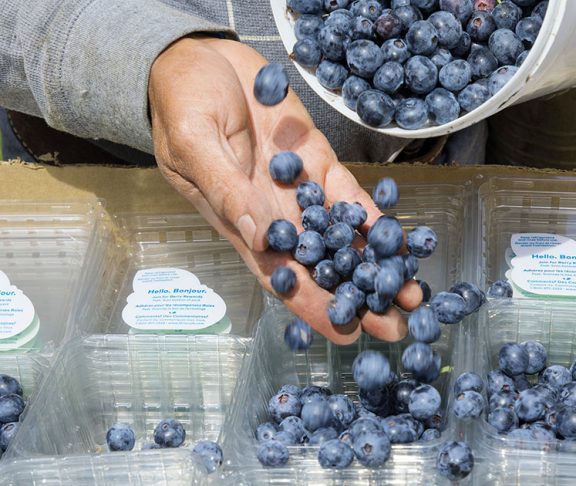The future of sustainable packaging will mean having readily available packaging solutions that protect the fruit and minimizes impact on the environment.
But it requires everyone to work together — including food producers and distributors, packaging manufacturers, material recovery facilities, and consumers — to ensure that the recyclable content of plastic containers is recovered and reprocessed into new packaging.
Until the 1990s, Driscoll’s berries were sold in baskets. Nowadays they’re sold in clear, vented plastic packaging known as a clamshell. These lightweight containers, made of recycled plastic water bottles, both protect the fruit from damage and contamination, as well as reduce food waste since it controls moisture and promotes extended shelf-life.
“Berries require maximum attention to detail when it comes to packaging and transportation. They’re delicate, perishable, and really sensitive to temperature changes,” says Camille Herrera, packaging development and sustainability manager for Driscoll’s, one of the world’s largest producers of fresh strawberries, blueberries, raspberries, and blackberries. “It is our goal to have the berries placed into a refrigerated cooler or truck within two-and-a-half hours of them being harvested to ensure the highest quality berries are then shipped to retail stores around the country.”
Sustainable packaging
Driscoll’s, which has over 100 years of farming heritage, is committed to growing in harmony with the environment and communities which they depend on.
“Driscoll’s is a family-owned company and one of the things that sets us apart is we pride ourselves on being rooted in the communities in which we grow. We recognize that our consumers and communities deserve packaging solutions that do not put additional strain on local infrastructure and resources and can close the loop on plastic use,” says Camille Herrera.
They’re advocates for pre-competitive collaborations, working with competitors to find environmentally friendly packaging solutions that benefit everyone. For example, they and over 20 others across the fresh berry industry have made a joint pledge called “Berry Sustainable” to achieve 100 percent recycle-ready packaging by 2025. In addition to their industry wide commitments, Driscoll’s is the first U.S. produce company to join The New Plastics Economy Global Commitment, which is led by the Ellen MacArthur Foundation.
Closing the loop
Currently Driscoll’s clamshells contain over 50 percent recycled polyethylene terephthalate (PET), sourced mainly from recycled bottles. In an effort to promote more of a closed-loop system, their goal is to incorporate 25 percent recycled content from post-consumer recycled clamshells by 2025. By working with packaging suppliers to close the loop on clamshell recycling, it is estimated that in 2021 Driscoll’s will keep over 7.9 million lbs of PET clamshells from ending up in the landfill and reduce GHG emissions by 4.2MT CO2. The equivalent of removing 887 passenger vehicles from the road annually.
Driscoll’s encourages consumers to learn more about their local recycling policies or look for the How2Recycle label to ensure they are recycling the clamshells properly. Proper disposal will help minimize contamination of recycling bins so that local material recovery facilities can sort out the clamshells and bale them to be sold.
“If it can’t be sold, there’s no recycled material for our packing manufacturers to buy,” says Herrera. “By creating this demand, we’re signaling to the consumer that we are serious about recovering our packaging, we’re signaling to the recycling industry that we want them to collect clamshells because they’ll be able to sell them. And we’re telling manufacturers that we want them to buy recycled content to use in new packaging.”
They encourage other companies to commit to transparency, engage with their suppliers, and to learn the recycling landscape.
“To make the biggest impact, you have to collaborate. I’d encourage folks to meet with all stakeholders and share learnings to help advance recycling solutions.” says Herrera. “This should just be the new bar.”
Check out Driscoll’s online at @driscollsberry for their latest product and packaging innovations.




